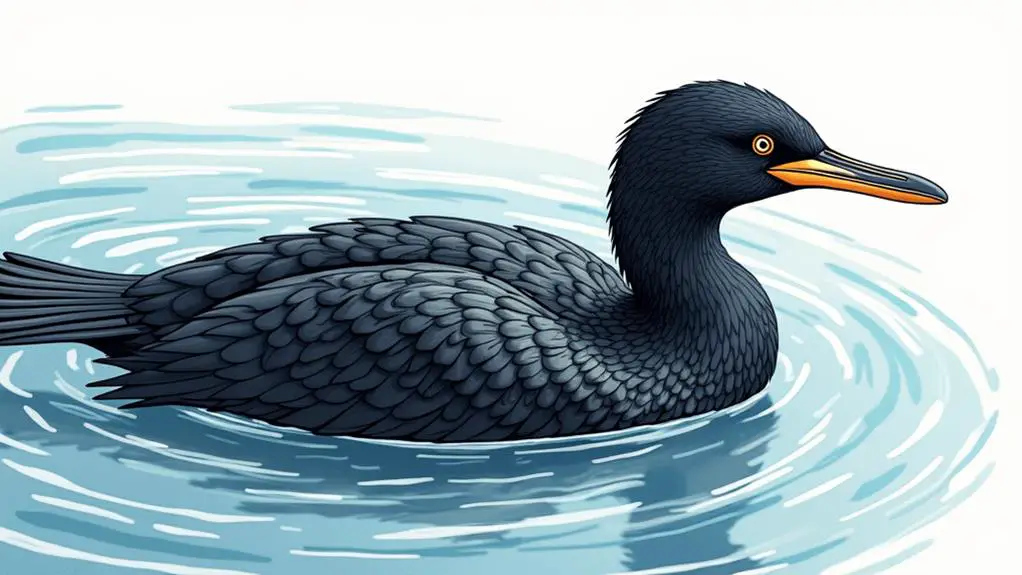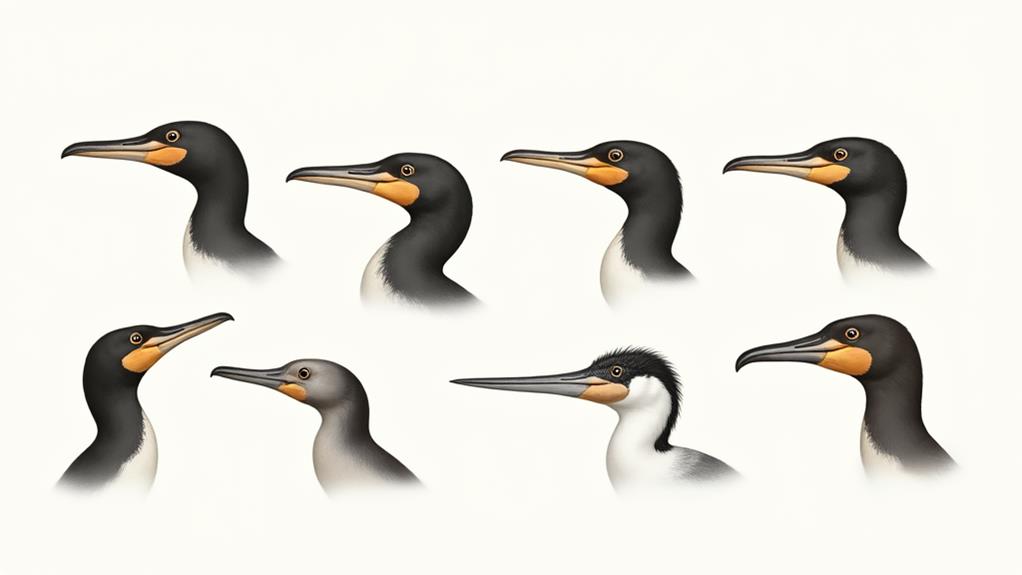As you observe Phalacrocoracidae Cormorants and Shags, you can't help but notice their striking appearance. But it's not just their sleek feathers and agile bodies that set them apart – it's the remarkable adaptations that enable them to dominate aquatic environments. From their specially designed eyes to their powerful webbed feet, every feature seems tailored for success in the water. And yet, despite their impressive physical attributes, there's still more to uncover. You'll soon discover that their unique beak shapes, intelligent hunting strategies, and complex social behaviors only scratch the surface of what makes these birds truly remarkable.
Key Takeaways
- Phalacrocoracidae's unique feather structure provides exceptional insulation, buoyancy, and water-repellent properties, making them well-suited for aquatic life.
- Their eyes are adapted for underwater vision, with enhanced polarization, binocular vision, and double eyelids for protection and precise hunting.
- Webbed feet enable efficient propulsion, maneuverability, and drag reduction, making them highly effective predators in their aquatic environment.
- Phalacrocoracidae employ intelligent hunting strategies, including stealthy pursuits, coordinated attacks, and ambush tactics, demonstrating adaptability and flexibility.
- Their social structure is characterized by complex colony dynamics, hierarchical interactions, and cooperative behaviors, such as alloparenting, highlighting the importance of sociality in their colonies.
Feathered Secrets of Buoyancy

Across the surface of the water, you'll often find Phalacrocoracidae, expertly exploiting the principles of buoyancy to hunt and thrive.
As you observe these birds, you'll notice their unique feather structure plays a crucial role in their ability to remain afloat. The feathers' micro-structure, consisting of a central shaft (rachis) and vanes (barbs), allows for an intricate network of air-filled cavities.
This remarkable design provides exceptional insulation properties, reducing heat loss and maintaining a stable body temperature.
When you examine the feathers more closely, you'll find that the barbs are coated with a waxy substance, which helps to repel water and reduce its penetration.
This adaptation enables Phalacrocoracidae to maintain a layer of air next to their skin, further enhancing their buoyancy. Additionally, the feathers' flexibility allows them to compress and expand, adjusting to the surrounding water pressure.
This remarkable combination of feather structure and insulation properties enables Phalacrocoracidae to conserve energy while swimming and diving, making them highly efficient predators in their aquatic environment.
Diving Champions of the Deep
Phalacrocoracidae's diving prowess is a testament to their remarkable physiological adaptations, allowing them to plunge to depths that would be hostile to most other birds. As you explore the world of cormorants and shags, you'll discover that these birds have evolved extraordinary diving reflexes to navigate the underwater realm. Their ability to withstand saltwater's corrosive effects is a crucial aspect of their success.
| Diving Feature | Physiological Adaptation | Benefit |
|---|---|---|
| Diving depth | Increased myoglobin in muscles | Enhanced oxygen storage |
| Diving duration | Slowed heart rate | Reduced oxygen consumption |
| Saltwater tolerance | Specialized nasal glands | Excretes excess salt |
| Underwater vision | Tapetum lucidum reflective layer | Enhanced low-light vision |
| Buoyancy control | Air-filled feathers and bones | Optimized swimming efficiency |
These remarkable adaptations enable Phalacrocoracidae to dive to depths of up to 25 meters (82 feet) in search of fish, crustaceans, and other aquatic prey. As you delve deeper into the world of cormorants and shags, you'll appreciate the intricate complexities that make them diving champions of the deep.
Unique Beak Shapes Explained

You'll observe that Phalacrocoracidae beaks are uniquely shaped to facilitate fish capture.
Their hooked tips and conical shapes enable efficient grasping and holding of slippery prey.
These adaptations have evolved to complement their exceptional swimming and foraging abilities.
Beak Adaptations for Fish
One of the most distinctive features of cormorants and shags is their uniquely shaped beaks, adapted to excel in their primary role: catching fish.
As you examine their beaks, you'll notice they're designed to function like fish traps, with a distinctive hook at the tip. This curve allows them to catch and hold onto fish, preventing them from escaping.
The beak's strength is remarkable, capable of withstanding the struggles of a fish trying to break free. The upper mandible is also slightly larger than the lower, creating a vice-like grip that ensures a secure catch.
Additionally, the beak's shape enables cormorants and shags to maneuver fish into a position for swallowing, often using their beak as a makeshift anvil to stun or kill their prey.
These adaptations have evolved to optimize their fishing success, making them highly efficient predators in their aquatic environment.
Efficient Diving Tools
How do cormorants and shags manage to dive to such remarkable depths in search of prey, only to emerge with a struggling fish clutched tightly in their beaks?
It's all about their efficient diving tools. You see, these birds have evolved unique adaptations to thrive in their aquatic environment.
Their diving reflexes, also known as the bradycardic response, slow down their heart rate, reducing oxygen consumption and allowing them to conserve energy. This response is triggered by the sudden change in pressure and temperature when they dive.
Additionally, their air sacs, located beneath their skin and within their bones, help to reduce their overall density. This buoyancy aid enables them to dive more efficiently, using less energy to swim downward.
As they descend, the air sacs compress, allowing the birds to equalize the pressure in their ears and sinuses. When they resurface, the air sacs expand, helping them to regain buoyancy.
These remarkable adaptations make cormorants and shags highly effective predators, capable of catching fish in even the most challenging underwater environments.
Eyes Adapted for Aquatic Life
You'll observe that Phalacrocoracidae's eyes have evolved to excel in aquatic environments, boasting enhanced underwater vision that allows them to detect prey beneath the surface.
This adaptation enables them to hunt effectively, even in murky or low-light conditions. In fact, their eyes are capable of adjusting to varying light levels, ensuring they can navigate and forage with precision in both bright and dimly lit aquatic settings.
Enhanced Underwater Vision
Their ability to thrive in aquatic environments is largely due to their exceptional eyesight, which has adapted to the demands of underwater hunting.
As you observe these birds, you'll notice their eyes are specially designed to tackle the challenges of aquatic vision. The structure of their eyes allows them to focus both in and out of water, thanks to a unique, flexible lens that changes shape to accommodate these different environments.
Some key features of their enhanced underwater vision include:
- Polarized lenses: reducing glare from the water's surface, allowing them to see more clearly
- Aquatic gaze: their eyes are positioned on the front of their head, enabling binocular vision and precise judgment of distances underwater
- Wide pupils: letting in more light and enhancing their ability to detect prey in murky or low-light conditions
- Double eyelids: protecting their eyes while swimming and allowing them to blink rapidly to remove excess water
Adaptation to Low Light
In the dimly lit aquatic environment, where sunlight barely penetrates, Phalacrocoracidae's eyes have evolved to excel in low-light conditions, allowing them to capitalize on the abundance of prey that thrives in these settings.
You'll notice that their eyes are highly sensitive to light, which enables them to detect even the faintest glows. This heightened light sensitivity allows them to navigate and hunt in environments where other birds would struggle to see.
As you observe Phalacrocoracidae's eyes, you'll see that they've a reflective layer called the tapetum lucidum, which helps to amplify available light.
This layer, combined with their large pupils, enhances their visual flexibility, enabling them to adapt to changing light conditions. Additionally, their eyes have a high concentration of rods, which are sensitive to low light levels, further improving their ability to function in dimly lit environments.
These remarkable adaptations enable Phalacrocoracidae to thrive in aquatic environments where light is scarce, giving them a distinct advantage over other predators.
Webbed Feet for Propulsion

Powerful propulsion is key to a Phalacrocoracidae's aquatic success, and their webbed feet play a crucial role in achieving it.
You'll notice that their feet are specially adapted for this purpose, with a unique flipper design that allows for efficient energy transfer from the legs to the water.
This design enables them to generate significant thrust and maneuverability, making them highly effective predators in their aquatic environment.
Some key features of their webbed feet include:
- Foot flexibility: Their feet are highly flexible, allowing them to rotate their ankles and toes to achieve a powerful stroke.
- Webbed toe structure: The webbing between their toes is designed to reduce drag and maximize propulsion, with a unique structure that allows for a smooth flow of water over the foot.
- Powerful leg muscles: Their leg muscles are highly developed, providing the necessary power to drive their propulsion system.
- Streamlined foot shape: The shape of their feet is streamlined, reducing drag and allowing them to move effortlessly through the water.
Camouflage and Countershading
Deception is a vital aspect of a Phalacrocoracidae's survival strategy, and they've mastered the art of camouflage and countershading to remain inconspicuous in their aquatic environment.
You see, these birds have evolved to blend in with their surroundings, exploiting the visual limitations of predators and prey alike. They achieve this through color deception, where their feathers display a range of muted colors that mirror the shades of the water and surrounding vegetation.
Pattern disruption is another key component of their camouflage strategy.
The intricate patterns on their feathers, including spots, stripes, and mottling, create a visual "noise" that breaks up their outline, making it difficult to discern their shape and size. This disruption of patterns also helps to conceal any movement, allowing them to remain still and wait for prey or avoid predators.
Intelligent Hunting Strategies
Perched atop a submerged rock or hidden behind a veil of aquatic vegetation, you're likely to find a Phalacrocoracidae lying in wait, its eyes fixed intently on the water below.
Its intelligent hunting strategies allow it to thrive in its aquatic environment. As a skilled predator, it employs a range of tactics to catch its prey.
Some of its notable hunting strategies include:
- Stealthy pursuits: Phalacrocoracidae can swim silently, getting close to their prey before striking with lightning-fast speed.
- Coordinated attacks: These birds have been observed working together to herd fish into tight spaces, making it easier to catch them.
- Ambush tactics: They'll often lie in wait, remaining still and silent, until unsuspecting prey swims close enough to be snatched up.
- Adaptable foraging: Phalacrocoracidae can adjust their hunting style depending on the environment and prey, demonstrating a high degree of flexibility and intelligence.
Social Birds With Complex Colonies
In their breeding grounds, you'll often find Phalacrocoracidae congregating in dense, bustling colonies.
These aggregations are characterized by complex colony dynamics, with individuals interacting in a hierarchical manner. Within the colony, a social hierarchy is established, with dominant birds occupying central positions and subordinates relegated to the periphery.
This organization is crucial for maintaining order and reducing aggression among colony members.
As you observe these colonies, you'll notice that individuals engage in various social behaviors, such as preening, allopreening, and vocalizations.
These interactions serve to strengthen social bonds, reducing stress and promoting cooperation. In addition, Phalacrocoracidae have been observed exhibiting alloparenting behaviors, where non-breeding individuals assist in chick-rearing, further highlighting the importance of sociality in their colonies.
The intricate social structure of Phalacrocoracidae colonies is a testament to their adaptability and ability to thrive in a variety of environments.
Evolutionary History Revealed

Through fossil records and molecular analysis, the evolutionary history of Phalacrocoracidae has been reconstructed, revealing a complex and fascinating narrative.
You're about to uncover the secrets of these ancient birds, whose history dates back millions of years.
As you delve into the fossil records, you'll find that Phalacrocoracidae fossils have been unearthed from various parts of the world, including Europe, Africa, and Asia.
These ancient fossils provide valuable insights into the evolution of these birds over time.
Some key findings from the evolutionary history of Phalacrocoracidae include:
- Ancient fossils of Phalacrocoracidae have been dated back to the Eocene epoch, around 50 million years ago.
- Molecular clocks suggest that the common ancestor of all Phalacrocoracidae species lived around 20-30 million years ago.
- The earliest fossils of Phalacrocoracidae were found in Africa, indicating that this continent may be the birthplace of these birds.
- Phalacrocoracidae species have undergone significant adaptations to their environment over time, resulting in the diverse range of species we see today.
These discoveries have significantly enhanced our understanding of the evolutionary history of Phalacrocoracidae, providing a fascinating glimpse into the lives of these enigmatic birds.
Frequently Asked Questions
Can Cormorants and Shags Be Found in Freshwater Environments?
You'll find that cormorants and shags can indeed inhabit freshwater environments, thanks to their freshwater adaptations, although they generally prefer coastal and marine habitats, indicating a flexibility in their habitat preferences.
Do Cormorants and Shags Make Good Pets?
You might think cormorants and shags make great pets due to their social bonding nature, but they require intense emotional connection and specialized care, making them unsuitable for most owners, necessitating experienced handlers and large enclosures.
Are Cormorants and Shags Protected by Conservation Laws?
As you wade through the marshy waters, a tangled tapestry of life unfolds. You'll find that, yes, cormorants and shags are protected by conservation laws, ensuring habitat preservation and species classification for these avian wonders.
Can Cormorants and Shags Be Domesticated for Fishing?
You can't domesticate cormorants and shags for fishing, as they're wild birds with innate hunting instincts; developing effective fishing techniques requires specialized training methods, and these birds' natural behavior can't be adapted for human-directed fishing activities.
Are Cormorants and Shags Known to Carry Diseases?
Are you aware that wild birds can harbor diseases without showing symptoms? You should know that cormorants and shags can carry Avian cholera and bacterial infections, posing a risk to other birds and potentially even humans.
Conclusion
As you delve into the world of Phalacrocoracidae, you're struck by the stark contrast between their awkward, land-dwelling gait and their fluid, streamlined presence underwater. Yet, it's this very dichotomy that highlights the remarkable adaptability of cormorants and shags. Their unique features, from buoyant feathers to specialized eyes, beaks, and feet, have evolved in perfect harmony to conquer the aquatic realm. In this realm, they reign supreme, their intelligence and social complexity allowing them to thrive in environments that would be hostile to lesser creatures.





